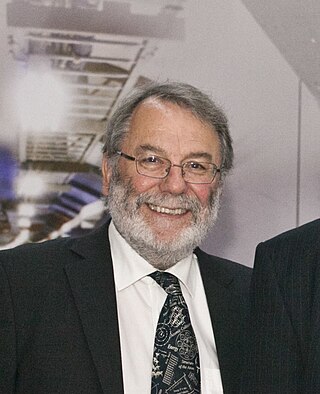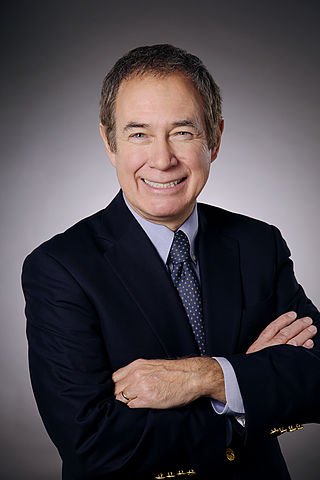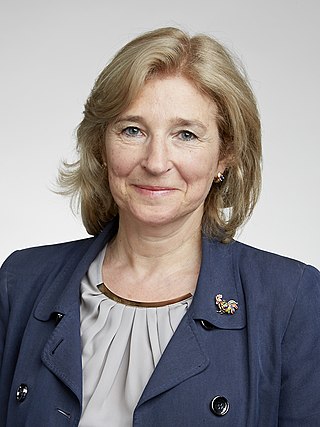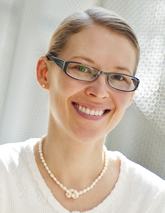Related Research Articles

Sir Charles Kao Kuen was a Chinese physicist and Nobel laureate who contributed to the development and use of fibre optics in telecommunications. In the 1960s, Kao created various methods to combine glass fibres with lasers in order to transmit digital data, which laid the groundwork for the evolution of the Internet and the eventual creation of the World Wide Web.

Sir Richard Henry Friend is a British physicist who was the Cavendish Professor of Physics at the University of Cambridge from 1995 until 2020 and is Tan Chin Tuan Centennial Professor at the National University of Singapore. Friend's research concerns the physics and engineering of carbon-based semiconductors. He also serves as Chairman of the Scientific Advisory Board of the National Research Foundation (NRF) of Singapore.
Sir David Neil Payne is a British professor of photonics who is director of the Optoelectronics Research Centre at the University of Southampton. He has made several contributions in areas of optical fibre communications over the last fifty years and his work has affected telecommunications and laser technology. Payne’s work spans diverse areas of photonics, from telecommunications and optical sensors to nanophotonics and optical materials, including the introduction of the first optical fibre drawing tower in a university.

Sir Peter Leonard Knight is a British physicist, professor of quantum optics and senior research investigator at Imperial College London, and principal of the Kavli Royal Society International Centre. He is a leading academic in the field of quantum optics and is the recipient of several major awards including the Royal Medal from the Royal Society and the Thomas Young Medal and Prize from the Institute of Physics. He is a former president of the Institute of Physics and Optica, the first non North American-based person to take the position.

The Department of Materials Science and Metallurgy (DMSM) is a large research and teaching division of the University of Cambridge. Since 2013 it has been located in West Cambridge, having previously occupied several buildings on the New Museums Site in the centre of Cambridge.

Robert James Mair, Baron Mair is a geotechnical engineer and Emeritus Sir Kirby Laing Professor of Civil Engineering at the University of Cambridge. He is the Founding Head of the Cambridge Centre for Smart Infrastructure and Construction (CSIC). He was Master of Jesus College, Cambridge, from 2001 to 2011 and a fellow of St John's College, Cambridge, from 1998 to 2001. In 2014 he was elected a vice president of the Institution of Civil Engineers and on 1 November 2017 became the Institution's president for 2017–18, its 200th anniversary year. He was appointed an independent crossbencher in the House of Lords in 2015 where he has been active on matters relating to infrastructure, science and technology, and education. He was a member of its Select Committee on Science and Technology for four years, and has also been a member of Select Committees on Assessment and Management of Risk, and Education and Skills; he is presently a member of the Select Committee on the Built Environment.
William Alexander Gambling was a British electrical engineer.

Ian Hugh White is a British engineer. His previous roles include vice-chancellor of the University of Bath, Master of Jesus College, Cambridge, deputy vice chancellor of the University of Cambridge, van Eck Professor of Engineering, and head of the Photonic Research Group, comprising CMMPE, Centre for Photonic Systems, and Photonics and Sensors, in the Cambridge University Engineering Department.

Paul R. Prucnal is an American electrical engineer. He is a professor of electrical engineering at Princeton University. He is best known for his seminal work in Neuromorphic Photonics, optical code division multiple access (OCDMA) and the invention of the terahertz optical asymmetric demultiplexor (TOAD). He is currently a fellow of IEEE for contributions to photonic switching and fiber-optic networks, Optical Society of America and National Academy of Inventors.

Polina Leopoldovna Bayvel is a British engineer and academic. She is currently Professor of Optical Communications & Networks in the Department of Electronic and Electrical Engineering at University College London. She has made major contributions to the investigation and design of high-bandwidth multiwavelength optical networking.
Lin Li, FREng, CEng, FIET, FLIA, FCIRP, is a professor of laser engineering at the University of Manchester.

James Roy Taylor is an English physicist who is Professor of Ultrafast Physics and Technology at Imperial College London.

David John Richardson is a British optoelectronics researcher who is Professor and Deputy Director of the Optoelectronics Research Centre at the University of Southampton.
Govind P. Agrawal is an Indian American physicist and a fellow of Optica, Life Fellow of the IEEE, and Distinguished Fellow of the Optical Society of India. He is the recipient of James C. Wyant Professorship of Optics at the Institute of Optics and a professor of physics at the University of Rochester. He is also a Distinguished scientist at the Laboratory for Laser Energetics (LLE) in the University of Rochester. Agrawal has authored and co-authored several highly cited books in the fields of non-linear fiber optics, optical communications, and semiconductor lasers.

Alexandra Boltasseva is Ron And Dotty Garvin Tonjes Distinguished Professor of electrical and computer engineering at Purdue University, and editor-in-chief for The Optical Society's Optical Materials Express journal. Her research focuses on plasmonic metamaterials, manmade composites of metals that use surface plasmons to achieve optical properties not seen in nature.

Betty Lise Anderson is an American electrical engineer, working in the field of photonics. She has been a professor at the Ohio State University since 1990. She is a Fellow of SPIE, and a Senior Member of the Optical Society of America and of the Institute of Electrical and Electronics Engineers.
Tong Sun is a Professor of Sensor Engineering and Director of the Research Centre for Photonics and Instrumentation at City, University of London. She was awarded the Royal Academy of Engineering Silver Medal in 2016 and awarded an Order of the British Empire (OBE) in the 2018 Birthday Honours. In 2020 she was elected Fellow of the Royal Academy of Engineering.

Igor Meglinski is a British, New Zealand and Finnish scientist serving as a principal investigator at the College of Engineering & Physical Sciences at Aston University, where he is a Professor in Quantum Biophotonics and Biomedical Engineering. He is a Faculty member in the School of Engineering and Technology at the Department of Mechanical, Biomedical & Design Engineering, and is also associated with the Aston Institute of Photonic Technologies (AIPT) and Aston Research Centre for Health in Ageing (ARCHA).
John Ballato is an American materials scientist, entrepreneur, and academic. He holds the J. E. Sirrine Endowed Chair of Optical Fiber and is a professor of materials science and engineering, electrical and computer engineering, as well as physics and astronomy at Clemson University. He has received many international recognitions for his research on optical and optoelectronic materials, particularly as relates to optical fiber.
Anna C. Peacock is an electrical engineer specialising in photonics and fiber optics. Originally from New Zealand, she works in the UK as professor of photonics at the University of Southampton, where she heads the Nonlinear Semiconductor Photonics group of the Optoelectronics Research Centre.
References
- 1 2 3 4 "Prof Richard Penty". People of Today Online. Debrett's. Retrieved 12 October 2013.
- 1 2 3 4 "PENTY, Prof. Richard Vincent". Who's Who 2015. Oxford University Press. November 2014. Retrieved 9 September 2015.
- 1 2 "eComm seeks initial £500k". Business weekly. 7 June 2011. Retrieved 12 October 2013.
- ↑ Penty, Richard Vincent (1989). "Novel optical fibre Kerr devices for signal processing". EThOS. The British Library. Retrieved 11 September 2015.
- 1 2 3 "Professor Richard V Penty". College Fellows and Staff. Sidney Sussex College, Cambridge. Retrieved 12 October 2013.
- ↑ "Professor Richard Penty Elected as the 27th Master of the College". Sidney Sussex College, Cambridge. Retrieved 12 October 2013.
- ↑ "Zinwave Ltd".
- ↑ "List of Fellows". Royal Academy of Engineering. Retrieved 16 October 2013.